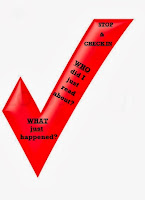Each year, after the first couple of weeks of school, I do a quick intro to the No Excuses list. This is a chart of things that, by the time they get to 4th or 5th grade, a student can reasonably be expected to be responsible for doing. Things like starting sentences with capital letters and putting endmarks on sentences. It is not unreasonable to expect those things of my students. However, I find so many of my friends do not have automaticity with them. They should be no-brainers, but my friends have shown (year after year) to be very lax in doing them.
To intro the chart, I have the chart done with just the title. I explain what a No Excuses list is. I tell them that this chart will have on it the things that we know every 4th and 5th grader has been taught in previous grades and can be expected to do when reading or writing. These are things your teacher this year should not have to teach again because you learned, practiced, and did them in 1st, 2nd, and/or 3rd grade. I then have the kids brainstorm a list of what they would put on the chart. THEY KNOW! They know what they should be doing! Without fail, every year, they come up with the exact things we need to have on our list.
I usually start with the top two; capitalizing sentences and using endmarks/end marks. (I always write endmarks as a compound word. I've seen it both ways band have just always written it as a compound word. Spell check does not agree!) We add teach item to the chart and in the bullet, put the date we add them to the chart. On my chart, the 27th and 28th were actually both added on the same day, but I was talking and writing at the same time and wrote the 28th by mistake. Except for those two items, I usually add items one at a time with at least a week or two between adding an item to the chart. This gives my friends time to work on each without being overwhelmed.
What makes the chart work is the rule. Once it is on the chart, from that date forward, it is expected to be done on all work. No Excuses! If a paper is turned in with any of these errors, the student will get the paper back to fix or redo. Or, if I notice it on the paper before they turn it in I will say that I can't accept that paper and they need to check the No Excuses chart. I find that it is usually not that kids can't do these things. It's more that we don't, at some point, draw that line in the sand and say, "Okay, this is now on you! You have been taught and/or retaught these things year after year and now it is your responsibility to do them without being told. No excuses!" I know this might sound harsh to some, but I promise you after just a couple of weeks you will see a dramatic drop in students forgetting to do these basic things. I find the key for me is to stick with the expectations and be consistent in not accepting work that doesn't meet the standard.
Now, I also know there may be some students you need to make exceptions for. But, in general, if something makes it on to your No Excuses list, everyone is usually expected to do it. What you have on your list can be tailored to the grade level, students' abilities, and the expectations you set in your classroom. You know your students best, so you have to create a list that works for you. The list can be added to as the year goes on, but I generally focus on things that have been taught in previous year(s) and are reasonable expectations of my students.
Is this something you think would work in your classroom?
What would be on your No Excuses list?
Or, do you handle this issue in another way
that might be good to share?




